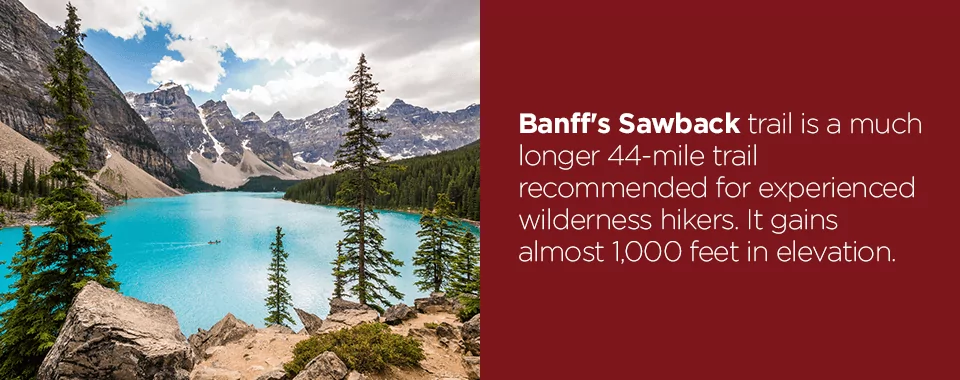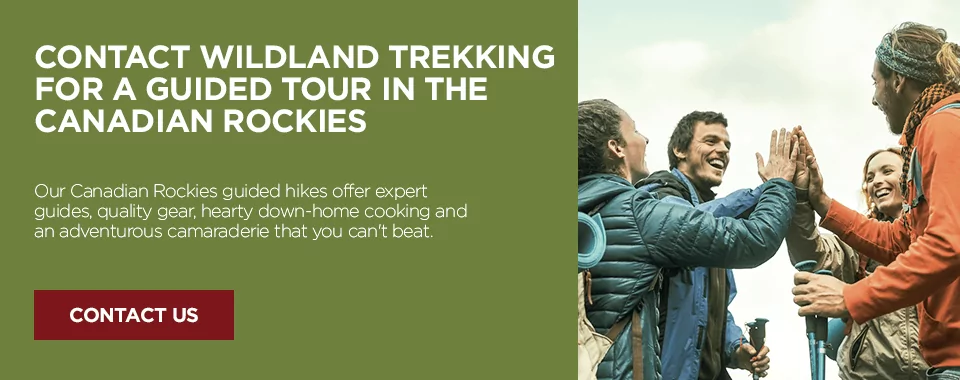Best Hikes in the Canadian Rockies

Hiking the Rocky Mountains in Canada offers a plethora of challenging, rewarding hikes and out-of-this-world views. Whether you travel to Banff National Park, Jasper National Park, Kootenay National Park or Yoho National Park — or set out a trail outside the national parks — you’ll find so much scenery, wildlife and adventure to reward your journey. Every year, millions of people travel to Banff — Canada’s first national park — to see Lake Moraine and Lake Louise and to experience everything else the park has to offer.
But sometimes the most challenging part of planning a hiking trip is figuring out where to go. What are the best hikes in the Canadian Rockies, and what do they have to offer? We’ve compiled the guide below to tell you just that.
Award Winning Canadian Rockies Treks
Why Hike the Canadian Rockies?
For many people, hiking the Canadian Rockies is a once-or-twice-in-a-lifetime bucket-list adventure. Reasons to hike the Canadian Rockies are almost too numerous to list, but here are a few.
- Scenic beauty: Canadian Rocky Mountain trails offer breathtaking scenic beauty, one wonder after the next. From rugged mountain peaks to green, primordial forests, from pristine, turquoise alpine lakes to delicate, colorful wildflowers sprouting up in snow-splashed meadows, the Canadian Rockies offer splendors you won’t soon forget. Bring your camera to capture some of the incredible beauty you’ll discover in the wilds of the Canadian Rockies.
- Landmarks: Canadian Rocky Mountain hikes also take you past many incredibly photogenic landmarks. Mount Assiniboine in Banff, a Matterhorn-type mountain, is one of the most striking and most photographed peaks in the Canadian Rockies. Moraine Lake is also one of the most photographed spots in the Canadian Rockies, and its breathtaking and famous neighbor Lake Louise, also located in the Valley of the Ten Peaks in Banff National Park, is not to be missed. There’s also the ice field of Athabasca Glacier in Jasper National Park. These landmarks and many more will form part of an inspiring, unforgettable experience hiking in the Canadian Rockies.
- Wildlife: The Canadian Rockies are home to many species of animals, including cougars, wolves, black and grizzly bears, lynxes, moose, elk, mountain goats, bighorn sheep, otters, marmots and many more. Even in wolf and grizzly country, traveling in large, noisy groups is extremely safe — and we always carry bear spray, just in case. Some of these creatures are elusive, but seeing an otter swimming in a mountain stream or watching a yearling black bear scamper in a distant meadow can make your hiking trip one you’ll never forget.
- Geology: The Rocky Mountains formed 65 to 35 million years ago in a geological event known as the Laramide Orogeny. During this period, the movements of the earth’s tectonic plates shoved sheets of limestone eastward over Mesozoic rocks, creating the stark Rocky Mountain Trench on the eastern side of the Northern and Canadian Rockies. This trench bears a topography carved by glaciers over time and is the reason the Rockies look so dramatic and majestic when viewed from the east. Geological activity in the Rockies has produced several different types of mountain peaks, from dogtooth to sawtooth to castellate to Matterhorn types, all beautiful and fascinating to see.
Explore Your World. Mountain & Canyon Adventures
What to Expect
What can you expect when you set out to hike in the Canadian Rockies?
- Elevation: Most of the best hikes in Canada gain some acute elevation, though the Canadian Rockies are a little lower than the Colorado Rockies. The highest peak in the Canadian Rockies is Mount Robson, at 12,972 feet, but generally, the elevations start around 4,000 feet and go up from there. Banff, the highest town in Canada, sits at an elevation of 4,537 feet. The air is much thinner at this elevation, and the thin air can lead to altitude sickness. For hikers coming in from sea level, it’s vital to take the increased elevation into account and give yourself time to acclimate. Take it slow for the first day or two, and drink plenty of water both before and during your trip.
- Moderate to strenuous difficulty: Between the altitude of the area and the elevation gains experienced during hiking, the Canadian Rockies tend to offer hiking trails of moderate to strenuous difficulty. But that fact doesn’t mean you can’t find easy, meandering trails — far from it. Strolling around a clear blue lake against a jagged mountain backdrop can be just as rewarding as summiting the highest peak.
- Changing weather conditions: Weather in the mountains changes dramatically and without warning. The morning could start fine and sunny, then dark afternoon thunderstorms could roll in. Or the morning might bring ice and snow, only to have the hot mountain sunshine melt them away. Come prepared with multiple layers and clothes for different types of weather — you’ll probably need them all.
- Plentiful sights at different times: Many people wonder when the best time of year is for visiting the Canadian Rockies. You’ll see amazing sights no matter when you go, but many people prefer spring and fall. Spring is a time for cute, tiny baby animals, and it also draws fewer crowds than the summer months, though snowpack can be an issue on some hikes. In the summer, you may encounter more people, but you’ll also meet with a rainbow of colorful wildflowers dotting the mountainsides. In the fall, the aspens turn bright, beaming yellow, and the coniferous larches change color as well. Winter, of course, is cold, harsh and snowy — perfect for skiing, but less so for hiking.
Best Hikes in the Canadian Rockies
This area offers a multitude of amazing trails, and it’s hard to choose just a few. But here are our picks for some of the best hikes in the Canadian Rockies.
1. banff’s The Plain of the Six Glaciers
A tour around Banff is always magical, and this hike, one of the best day hikes in the Canadian Rockies, is no exception. Banff’s Plain of the Six Glaciers trail is a beautiful 8.5-mile hike with an elevation gain of about 2,000 feet. You’ll start this hike at Lake Louise, at Fairmont Chateau, and you’ll follow a relatively flat trail for the first few miles. Then you’ll ascend in elevation on a mostly gradual incline — you get a magnificent bird’s-eye view of Lake Louise below. Stop and have tea at the tea house, and then continue your journey on this approximately four-hour out-and-back trail. Be sure to keep an eye out for mountain goats on the way.
2. Banff’s Sawback Trail
Banff’s Sawback trail is a much longer 44-mile trail recommended for experienced wilderness hikers — it gains almost 1,000 feet in elevation. You’ll need a few — maybe four or five — days to check this point-to-point trail off your list, but if you’re up for the challenge, or you’re with a helpful guided tour, the effort is well worth it. Beautiful wildflowers dot the grass in the summer, and the trail cuts through the heart of Banff National Park, taking you from Cascade Amphitheater to Lake Louise on one of the best multi-day hikes in the Canadian Rockies. You’ll find ample opportunity to view wildlife along the way.

3. Floe Lake
Floe Lake Track is a spectacular trail in Kootenay National Park, southwest of Banff. This challenging 12-mile trail is not for the faint of heart — it features an elevation gain of almost 3,000 feet — but if you’re up for a strenuous adventure, the breathtaking views are more than worth it. You’ll likely need five or six hours to complete this out-and-back trail, which takes you through a series of switchbacks to a mesmerizing green-and-blue alpine lake. The lake also features a campsite for the option of a wonderful night of outdoorsy relaxing after your hike.
4. Larch Valley and Sentinel Pass
Larch Valley is a glorious trail, especially in the fall, when the larches turn a beautiful shade of yellow. The hike to Larch Valley takes about an hour, and you can stop there. Or, you can continue on the Sentinel Valley trail through the incredible mountain scenery of the Valley of the Ten Peaks for a more strenuous 6.8-mile hike that gains over 2,500 feet in elevation. This hike starts at the well-loved Moraine Lake in Banff and travels on to the top of Sentinel Pass for some fantastic views.
5. Lake O’Hara Alpine Circuit
The Lake O’Hara Alpine Circuit is a splendorous trail in Yoho National Park, northwest of Banff. This moderately difficult loop trail traverses about 6.5 miles of terrain for an elevation gain of 2,900 feet. The reward at the end of this hike, which can take up to six hours, is a panoramic vista of breathtaking mountain peaks and pristine turquoise alpine lakes. If you’re in Yoho, don’t miss this hike — you need a reservation, though, for the bus to the trailhead, which runs only a few times a day.
6. Tent Ridge
Tent Ridge Horseshoe, located near Banff and close to Canmore, Alberta, is a strenuous mountain trail that features abundant wildflowers in the summer, along with plentiful birds and opportunities to glimpse other wildlife. This 6.2-mile loop hike features an elevation gain of 2,700 feet and is easiest if you follow the loop clockwise. Either way you go, the prominent ridge will greet you with craggy mountain vistas in every direction, along with spectacular forests and alpine lakes below.
7. Mount Smutwood
The trail up Mount Smutwood is an out-and-back trail that features two lovely alpine lakes, as well as an incredible view of the cathedral-like Mount Birdwood. The hike is about 11 miles and gains over 3,100 feet of elevation, so it can be quite a scramble to the top, but the views make up for the steep climb. Plan to spend about six hours on this unforgettable trail.
8. Aylmer Pass
Located in Banff, the Aylmer Pass trail is a strenuous 17.5-mile out-and-back trail that leads to a picturesque alpine lake dotted with coniferous trees, with more gorgeous mountains in the distance. It gains a whopping 4,192 feet in elevation, most of that coming in the last bit of outward hiking, but if you can handle some burning quads and heavy breathing, the reward is a magnificent view. You’ll likely need a whole day for this hike, or you can camp at the pass.
Contact Wildland Trekking for a Guided Tour in the Canadian Rockies
When a professionally led, fun and safe adventure trekking in the Canadian Rockies sounds like the adventure you’ve been waiting for, hop onto a tour with Wildland Trekking. Our Canadian Rockies guided hikes offer expert guides, quality gear, hearty down-home cooking and an adventurous camaraderie that you can’t beat. Wildlife and unimaginable scenery abound when you’re hiking the Canadian Rockies, and we’re here to show you the best of it.





